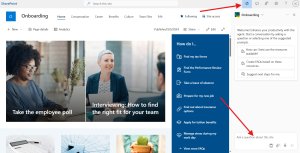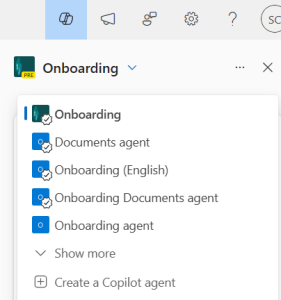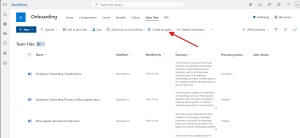Copilot Agents for SharePoint (watch my walkthrough), the newest feature for SharePoint Online, is currently rolling out to tenants. I’ve been playing around with it, and here’s my preliminary thoughts. I’m sure they’ll change as I get more experience, but many people don’t have this yet and some haven’t even heard of this. Part of that is due to Microsoft’s rebranding at the last minute, since for most of the year it was called Click-to-Copilot. Let’s go through what this does well, not so well, and REALLY not well.
The Good
So what’s good? Well, honestly this is the biggest and most ambitious feature I’ve seen from Microsoft in the SharePoint Online space. In short, this feature adds Copilot to your SharePoint site. That Copilot is grounded on the site’s data, and nothing else. That means your prompting skills don’t have to be amazing to get answers only based on the SharePoint site they’re on.
the biggest and most ambitious feature I’ve seen from Microsoft in the SharePoint Online space. In short, this feature adds Copilot to your SharePoint site. That Copilot is grounded on the site’s data, and nothing else. That means your prompting skills don’t have to be amazing to get answers only based on the SharePoint site they’re on.
The perfect use case is an HR site where instead of searching using Microsoft Search, or pouring through various PDFs, you can ask a chatbot what the holiday schedule is for this year. You could ask about insurance benefits, or the paid leave policy. It’s genius, and badly needed on document-heavy SharePoint sites.
It doesn’t stop there, because users (with edit rights) can create their own Copilot agent on a site grounded to that same data, a subset (think specific libraries, folders and files), or even a superset (think multiple SharePoint sites).
These Copilot Agents live as files in your document libraries. Deleting them consists of simply deleting that .copilot file associated with your agent. It’s really that simple.
You can share these Copilot agents with other users as well (just by sharing the file!), but again, it doesn’t stop there. You can customize these Copilot agents with helpful welcome messages, starter prompts, and custom behavior. Normal and power users will really like this, in my opinion. Soon, you’ll even have the ability to customize your Copilot agent in Copilot Studio, adding in advanced features previously exclusive to custom copilots.
From a site owner perspective, you can take the most valuable Copilot agents that your site members created and “approve” them, which merely comprises of moving them into:
Site Assets -> Copilots -> Approved
And now those relocated Copilots show up for all users and have a nice checkmark next to them, indicating that they’re approved Copilots.
show up for all users and have a nice checkmark next to them, indicating that they’re approved Copilots.
The Bad
I was sure that this would be a free feature and show all organizations the power of Copilot. I was wrong, because as it turns out, you’ll need a Copilot for M365 license to use and create Copilot agents. You won’t even see the new UI elements to trigger the Copilot panel if you don’t have the license.
I get it. AI is an expensive process, resource-wise. If your organization is already invested in Copilot for M365, this is a BIG added value! If you’re not invested, however, you won’t get this as a “free taste” which I think is a disappointment. That approach could have really done well to sell those M365 Copilot licenses, even if it was limited to just the default site-grounded Copilot for each site.
Another issue I see with how Copilot Agents for SharePoint is implemented is that it’s too easy to create them. That sounds crazy, so let me explain. When you select some files, for example, you’ll see the button called “Create an agent”. Once you create this, you’re basically done. You’re given the option to test it or edit it. Unless you edit this new agent, you won’t even notice the option to rename it, which will have a default naming convention, In my own tests, I ended up with multiple Copilot agents called “Documents agent”, since mine were based on that default “Documents” library.
Without proper training, users will undoubtably forget/ignore the option to give your agent a proper name, so that all users know what this Copilot agent is for. I see messy sites in the future with multiple agents named the same thing.
While I love the idea of creating a new Copilot agent so easily, forcing the user to name it something “proper” would have been a great feature. Site owners across the globe would have loved it, at the very least.
The Ugly
Governance is a major initiative with all organizations, but most especially those who are preparing to implement or have already implemented Copilot for M365. Data has to be controlled and secured. Features have to be introduced slowly, to ensure adoption and success.
That’s where we come to the problem. If you’re already licensed for Copilot for M365, this feature is automatically deployed al all SharePoint sites. No option to disable currently exists without using Restricted Content Discoverability, a feature of SharePoint Advanced Management (SAM). If you’ve never heard of SharePoint Advanced Management, it’s part of SharePoint Premium, a set of features that enable a lot of governance and AI processing capabilities to your environment.
I don’t think most organizations will like this. For one, they have OCM processes to help users adjust to AI in their lives, ensuring they not only know how to use it responsibly, but are productive with it. This throws a monkey wrench into things. No controlled rollout unless they also have SharePoint Advanced Management or are prepared to license all users for it. You cannot just license your administrators. All users will need the SAM license, which runs at $3/user/month currently.
I think it’s strategic to raise awareness of SharePoint Advanced Management, which many customers are unaware of. I’m a big fan of SAM, to be honest, but I think that this feature should have been made available to those who have M365 Copilot licenses.
Conclusion
Do the good things outweigh the bad and the ugly? I think it depends on who ask. In my opinion, it’s a resounding YES.
Overall, I’m very excited about Copilot Agents for SharePoint, and have been since I first heard about it. Governance has a long way to go with this, however, and I’m not looking forward to having difficult talks with customers about their concerns, which I imagine will be similar to my own. Aside from that, I think users will really like this.
I think there’s tremendous potential with this feature, and I’m already imagining how this will help site authors create content for their pages, not to mention the possibilities of integrating Designer into the mix. We’ll see what future plans Microsoft has for this amazing feature, but there may be some surprises next week at Microsoft Ignite!



